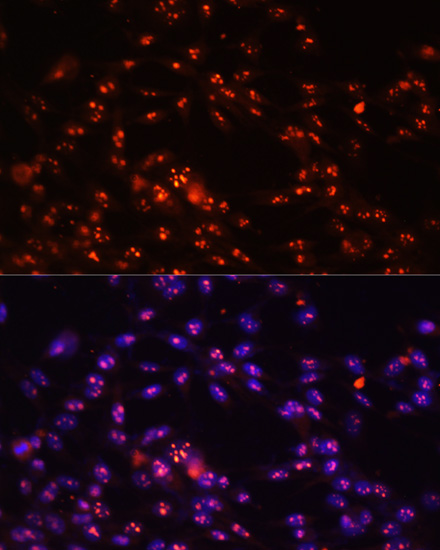-
Product Name
DKC1 Polyclonal Antibody
- Documents
-
Description
Polyclonal antibody to DKC1
-
Tested applications
WB, IHC, IF
-
Species reactivity
Human, Mouse
-
Alternative names
DKC1 antibody; CBF5 antibody; DKC antibody; DKCX antibody; NAP57 antibody; NOLA4 antibody; XAP101 antibody; dyskerin pseudouridine synthase 1 antibody
-
Isotype
Rabbit IgG
-
Preparation
Antigen: Recombinant fusion protein containing a sequence corresponding to amino acids 1-180 of human DKC1 (NP_001354.1).
-
Clonality
Polyclonal
-
Formulation
PBS with 0.02% sodium azide, 50% glycerol, pH7.3.
-
Storage instructions
Store at -20℃. Avoid freeze / thaw cycles.
-
Applications
WB 1:500 - 1:2000
IHC 1:50 - 1:100
IF 1:50 - 1:100 -
Validations

Western blot - DKC1 Polyclonal Antibody
Western blot analysis of extracts of various cell lines, using DKC1 antibody at 1:3000 dilution.Secondary antibody: HRP Goat Anti-Rabbit IgG (H+L) at 1:10000 dilution.Lysates/proteins: 25ug per lane.Blocking buffer: 3% nonfat dry milk in TBST.Detection: ECL Basic Kit .Exposure time: 60s.

Immunohistochemistry - DKC1 Polyclonal Antibody
Immunohistochemistry of paraffin-embedded human lung cancer using DKC1 antibody at dilution of 1:100 (40x lens).

Immunofluorescence - DKC1 Polyclonal Antibody
Immunofluorescence analysis of NIH-3T3 cells using DKC1 antibody at dilution of 1:100. Blue: DAPI for nuclear staining.

Immunofluorescence - DKC1 Polyclonal Antibody
Immunofluorescence analysis of U-2 OS cells using DKC1 antibody at dilution of 1:100. Blue: DAPI for nuclear staining.
-
Background
Isoform 1: Catalytic subunit of H/ACA small nucleolar ribonucleoprotein (H/ACA snoRNP) complex, which catalyzes pseudouridylation of rRNA. This involves the isomerization of uridine such that the ribose is subsequently attached to C5, instead of the normal N1. Each rRNA can contain up to 100 pseudouridine ('psi') residues, which may serve to stabilize the conformation of rRNAs. Required for ribosome biogenesis and telomere maintenance. Also required for correct processing or intranuclear trafficking of TERC, the RNA component of the telomerase reverse transcriptase (TERT) holoenzyme.; Isoform 3: Promotes cell to cell and cell to substratum adhesion, increases the cell proliferation rate and leads to cytokeratin hyper-expression.
Related Products / Services
Please note: All products are "FOR RESEARCH USE ONLY AND ARE NOT INTENDED FOR DIAGNOSTIC OR THERAPEUTIC USE"
